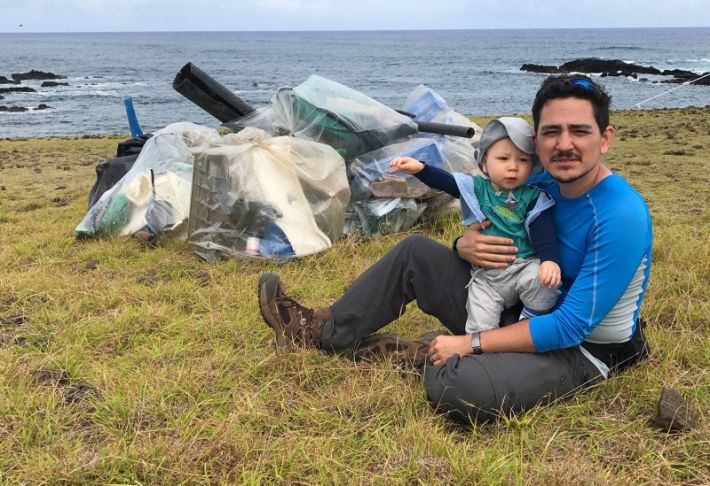In this Kūkahekahe Cultural Conversations article, we highlight the impactful documentary about Rapa Nui, “Eating Up Easter.” E ka ʻohana Kamehameha, we have an amazing opportunity to watch this documentary as part of a free Kaʻiwakīloumoku and ʻAha Moananuiākea screening to celebrate Earth Day! Click here to register to receive a link to the event, which will be available to stream online between April 22 and May 6, 2021.
The ancient moai, towering ancestral statues, against a backdrop of aquamarine waters have long been iconic images of the Polynesian island of Rapa Nui. Formerly known as Easter Island, it is one of the most remote locations in the Pacific. Less known is the 20 tons of daily trash and 40,000 plastic bottles packaged for recycling at the Orito Gathering Plant and shipped 2,200 miles away to Chile every month.
“Almost everything we own comes from somewhere else. But everything we throw away stays on our island,” says filmmaker and Rapanui native Sergio Mataʻu Rapu. Looking over bales of sorted and compressed plastic, Mama Piru Huke, a coordinator for Rapa Nui appointed by the mayor to work at the Oritu Gathering Plant notes, “Todo esto no es aqui - None of this is from here.”
The version of Rapa Nui that is lived by residents and natives of the island is one that Rapu shares in his 2018 documentary “Eating Up Easter.” Framed as a cinematic letter to his son, the film explores the tensions within an island community facing the globalizing effects of tourism while trying to protect their culture, identity, and ways of life for future generations.
The same issues and possible solutions in Rapa Nui have global applications but feel particularly relevant for us as island peoples in Hawaiʻi, especially as we seek new, more sustainable ways forward emerging from the global COVID-19 pandemic.
Rapa Nui is a territory of Chile and the eastern most island of Oceania, forming the eastern point of the Polynesian triangle with Hawai‘i in the north, and Aotearoa (New Zealand) to the southwest. It stands alone as a solitary island with Pitcairn its nearest neighbor some 2,200 miles away. Roughly the size of Niʻihau here in Hawaiʻi, its about 63 square miles and you can drive across the island in only twenty minutes.
Among the four native people whose stories are told in this film is the beloved advocate and community leader Mama Piru, who, before passing in 2018, was regularly invited to be on the island’s radio station to “call out” people who improperly disposed of trash and recyclables.
Classical pianist Mahani Teave Williams and construction engineer Enrique Icka Tepie cofounded the revolutionary NGO Toki Music School to reunite their divided community through cultural, environmental and arts education.
Former governor and native Rapanui anthropologist Sergio Rapu Haoa Sr., the filmmaker’s father, embraces change and economic opportunity in Rapa Nui. Their stories are intimate and familial in this documentary, which is likely because the people of Rapa Nui were excited to have a native son telling their stories to the world. In a vast archive of non-native documentaries that feature ancient stone monuments, Rapu uniquely centers on the living, vibrant, innovative, and proud people of Rapa Nui.
“One of the biggest misconceptions is that we died out because our people destroyed our environment. The trees did disappear, the good soil disappeared… But our people survived,” notes Rapu at a site where directors usually feature a lone coconut tree as an example of deforestation caused by the Rapa Nui people. “Just across the street, there’s a bunch of manawai (walled gardens) and also rock mulch gardens. They learned new and different ways of planting.”
Rapa Nui is also called Te Pito o Te Henua, “The navel of the world” by its native peoples. “If you imagine the world as an organism, with eyes and heart, with arms and legs, the island is the center of the body,” reflects Icka Tepie.
“Eating Up Easter” carries forward the beliefs of its people: that Rapa Nui can be a central example of sustainability for the world. When we speak about our culture, we speak about ourselves. “No importa denada hay tienes que amar a su gente; No matter what, you have to love your people,” reflected Mama Piru. “I am proud to be Rapa Nui, I am proud to be of the moai. We are the living statues. You and I, we are the living statues.”
Stay tuned for a new episode of Pacific Conversations with our partners in Rapa Nui, including a talk with “Eating Up Easter” filmmaker Sergio Rapu! The episode will premiere on our Kaʻiwakīloumoku website on April 28, 2021!

Filmmaker Sergio Mataʻu Rapu framed “Eating Up Easter” as a cinematic letter to his son. Here, he and his son after a coastal cleanup in Rapa Nui.

Beloved Rapa Nui community advocate Mama Piru Huke is featured in the documentary “Eating Up Easter.”

Mama Piru and volunteers collect trash and marine debris from a moai site in Rapa Nui.
TAGS
hookahua,
kaiwakiloumoku,
pacific conversations,
aha moananuiākea pacific consortium,
rapa nui
CATEGORIES
Kaipuolono Article, Regions, Themes, Culture, Community, Hawaii Newsroom, KS Hawaii Home, Kapalama Newsroom, Kapalama Home, Maui Newsroom, KS Maui Home, Newsroom, Campus Programs, Hawaii, Kapalama, Maui, Department News
Print with photos
Print text only










